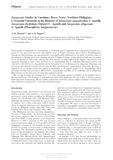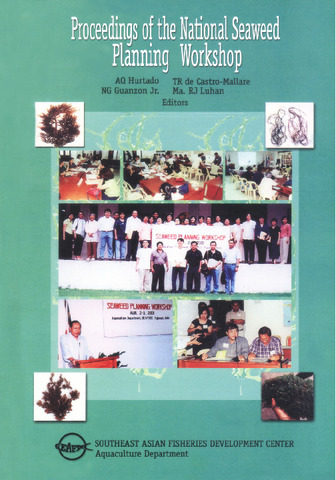Sargassum studies in Currimao, Ilocos Norte, Northern Philippines I. Seasonal variations in the biomass of Sargassum carpophyllum J. Agardh, Sargassum ilicifolium (Turner) C. Agardh and Sargassum siliquosum J. Agardh (Phaeophyta, Sargassaceae)
- Global styles
- MLA
- Vancouver
- Elsevier - Harvard
- APA
- Help

ดู/
วันที่
1999Page views
4,562ASFA keyword
AGROVOC keyword
Taxonomic term
เมตาดาต้า
แสดงระเบียนรายการเต็มCited times in Scopus
Share
นามธรรม
Three species of Sargassum (S. carpophyllum, S. ilicifolium and S. siliquosum were collected each month for a period of one year from the inter- and subtidal zones of Pangil, Currimao, Ilocos Norte, The Philippines. Average monthly biomass was species-specific and significantly influenced by the effect of fertility states of the seaweed, collecting zone, and collecting months. A higher biomass of reproductive plants was accounted for in all species in both zones. Among the three species, S. siliquosum had the highest reproductive and vegetative biomass in both zones, followed by S. carpophyllum and S. ilicifolium. Maximum fertility was observed in October for S. carpophyllum and in November for S. ilicifolium and S. siliquosum. Minimum and maximum reproductive biomass was recorded in May and December, respectively in all species. Biomass of vegetative or non-fertile plants was highest in September in all species except for S. carpophyllum, while minimum biomass was recorded in March for S. carpophyllum and May for S. ilicifolium and S. siliquosum. Reproductive plants had more biomass than vegetative plants.
The average monthly wet biomass (g m−2) of other Sargassum species was higher in the subtidal than in the intertidal zone. The biomass of seaweeds associated with Sargassum did not follow a definite pattern. Although water temperature, pH and salinity values were relatively constant, slight variations of temperature were positively correlated (P = 0.05) with subtidal biomass.
การอ้างอิง
Hurtado, A. Q., & Ragaza, A. R. (1999). Sargassum studies in Currimao, Ilocos Norte, Northern Philippines I. Seasonal variations in the biomass of Sargassum carpophyllum J. Agardh, Sargassum ilicifolium (Turner) C. Agardh and Sargassum siliquosum J. Agardh (Phaeophyta, Sargassaceae). Botanica Marina , 42(4), 321-325. https://doi.org/10.1515/BOT.1999.036
Type
ArticleISSN
0006-8055คอลเลกชัน
- Journal Articles [1229]
Related items
Showing items related by title, author, creator and subject.
-
Changes in the fish diversity and abundance on a heavily fished fringing reef on Santiago Island, Pangasinan, Philippines
McManus, John W.; Nañola Jr., Cleto L.; Reyes Jr., Rodolfo B.; Kesner, Kathleen N. (Bureau of Agricultural Research, Department of Agriculture, 2007)Fish assemblages on the reef slope, reef flat, and seagrass beds on Santiago Island were sampled over 18 months in 1992-1993 as part of a 6-year reef monitoring project started in 1986. Abundance and species diversity were ... -
Seaweeds of Panay
Hurtado, Anicia Q.; Luhan, Maria Rovilla J.; Guanzon Jr., Nicholas G. (Aquaculture Department, Southeast Asian Fisheries Development Center, 2006)This practical book on the seaweeds of Panay, Philippines, acquaints and provides information to members of the academe and research institutions, policy makers, fishermen and businessmen regarding the taxonomy, distribution, ... -
Proceedings of the National Seaweed Planning Workshop held on August 2-3, 2001, SEAFDEC Aquaculture Department, Tigbauan, Iloilo
Hurtado, A. Q.; Guanzon Jr., N. G.; de Castro-Mallare, T. R.; Luhan, Ma. R. J. (Aquaculture Department, Southeast Asian Fisheries Development Center, 2002)Seaweed forming is one of the major livelihoods among coastal communities in the Philippines, particularly to some 180,000 families in the Sulu Archipelago. In 1999, the Philippines exported more than 35,000 tons of dried ...





